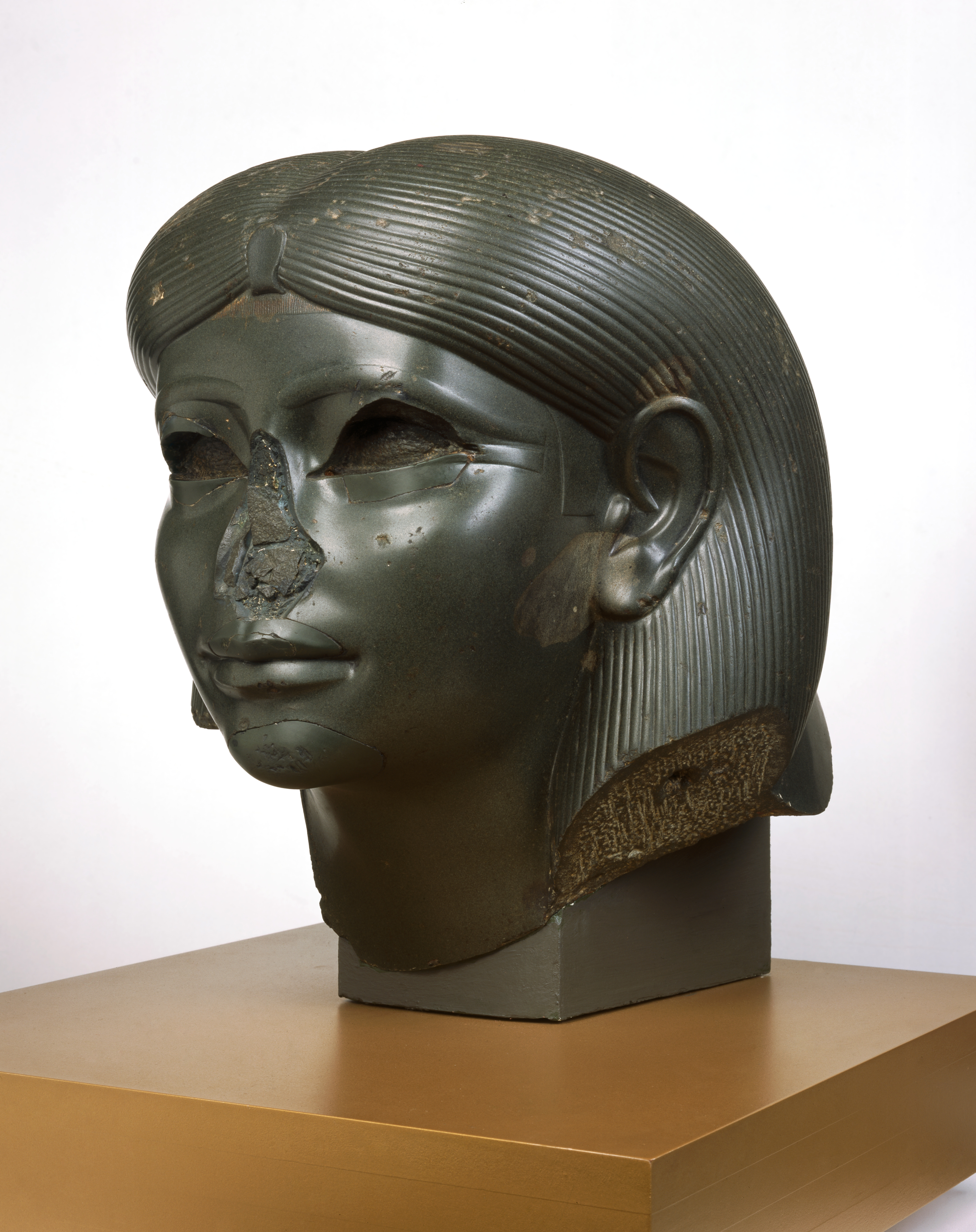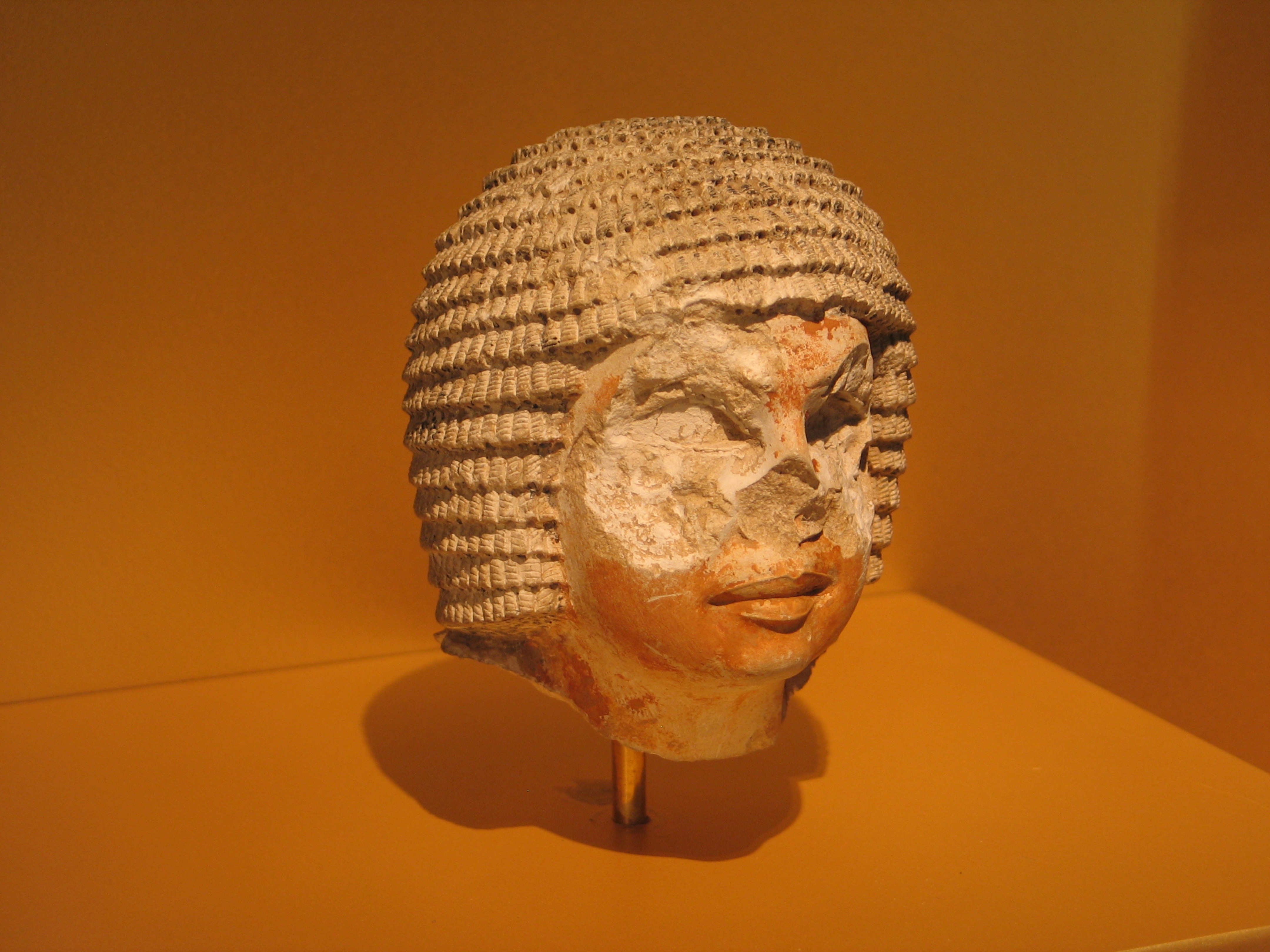
Why Are the Noses Broken on So Many Ancient Egyptian Statues?
Ancient texts provide a few clues.
Asked and answered: Frequent Art Questions is a monthly series that addresses frequently asked questions from Brooklyn Museum visitors about art and museum practices.
“Why are the noses broken?” This is one of the most common questions we hear about ancient Egyptian statues—especially those made of stone—in the Brooklyn Museum and around the world. Of course, noses stick out from the face and are therefore vulnerable to damage from erosion or accidents. However, a walk through our galleries suggests that missing noses are much more prevalent among ancient Egyptian statues than comparable works from other eras and regions, such as China. Could there be more to the story?
While modern-day looting is a serious issue, it's not thought to be responsible for the missing noses specifically. In fact, archaeologists continue to discover in situ statues that are missing their noses, indicating that this damage occurred centuries ago. Ancient texts give us clues about what may have happened. First, we know that the ancient Egyptians believed that a soul or a spirit could inhabit an image or object. An inscription about the goddess Hathor, found in the Dendera Temple complex—one of the most important religious sites in ancient times and home to an exquisitely preserved Temple of Hathor today—says, “She flies down into her body, she joins with her form.” Another inscription at the complex reads, “Osiris . . . comes as a spirit . . . He sees his mysterious form depicted in its place, his figure engraved on the wall; he enters into his mysterious form, alights on his image.” When the spirits of these deities entered their drawings and sculptures, they activated the objects (and the temple) as conduits for the living to communicate with the gods.
It wasn’t only deities who could inhabit images. Statues of deceased people in tombs and temples were treated as if they were alive; they were given offerings of food, drink, clothing, and anything else that the soul might need to survive in the afterlife.
The ancient Egyptians believed that a soul or a spirit could inhabit an image or object.
We also know that damage to statues was a serious concern, and perhaps even a serious crime, in pharaonic times. A royal decree found at the archaeological site of Coptos, Egypt, dating to the First Intermediate Period (circa 2170–2008 B.C.E.) and designed to protect a high-ranking official’s tomb, states, “As for anyone in this entire land who may do an injurious or evil thing to your statues . . . my majesty does not permit that their property nor that of their fathers remain with them, nor that they join their spirits in the necropolis, nor that they remain among the living.” This is one of several known texts that wish harm upon the souls of those who dare to damage tomb statuary.
Yet, as archaeologists have found, ancient looters did dare to damage statues in tombs, which would have been stocked with grave goods (luxury goods and daily necessities). Along with stealing this booty, raiders often attacked images of the tomb’s owner, especially the eyes and noses. Scholars interpret this as the looters’ attempt to prevent retaliation by the tomb owner’s soul. Such statues were understood to be “alive,” with a need to eat, drink, and breathe. Cutting off the nose would, in theory, be an effective way to cut off the statue’s source of breath with only a few blows of the chisel. The soul would then have no way to interact with the world of the living.
 Ancient Egyptian artist. Head from a Tomb Statue of a Man, circa 2500–2350 B.C.E. Limestone, pigment. Brooklyn Museum; Gift of the Ernest Erickson Foundation, Inc., 86.226.1.
Ancient Egyptian artist. Head from a Tomb Statue of a Man, circa 2500–2350 B.C.E. Limestone, pigment. Brooklyn Museum; Gift of the Ernest Erickson Foundation, Inc., 86.226.1.
On a more systematic scale, we see targeted damage to the images and names of problematic rulers. Two of the most famous examples are the female pharaoh Hatshepsut, whose unorthodox rise to the throne may have raised questions about future succession, and Akhenaten, whose unprecedented changes to religion led detractors to brand him a heretic and attempt to erase him from the historical record.
During the fourth and fifth centuries, Christianity became the dominant religion in Egypt. With that came a rejection of the old gods, but people were still aware of the power that “living” statues held to those who believed in them. Some particularly zealous church leaders, such as Saint Shenoute and Saint Augustine, advocated for attacks on “idols”—religious images meant to be worshiped—as a way to demonstrate their failure in the face of Christian might. A biography of Saint Shenoute, written by his successor, describes two times that he journeyed to destroy “pagan” statuary, and we can assume that there were more.
 Ancient Egyptian artist. Djehuti, circa 1539–1390 B.C.E. Limestone. Brooklyn Museum; Charles Edwin Wilbour Fund, 37.30E.
Ancient Egyptian artist. Djehuti, circa 1539–1390 B.C.E. Limestone. Brooklyn Museum; Charles Edwin Wilbour Fund, 37.30E.
 Ancient Egyptian artist. Amunhotep, Son of Nebiry, circa 1426–1400 B.C.E. Limestone, pigment. Brooklyn Museum; Charles Edwin Wilbour Fund, 37.29E.
Ancient Egyptian artist. Amunhotep, Son of Nebiry, circa 1426–1400 B.C.E. Limestone, pigment. Brooklyn Museum; Charles Edwin Wilbour Fund, 37.29E.
In some cases, losing a nose was getting off easy. Why were certain statues completely destroyed while others forfeited only an appendage? Comparing two statues of scribes, both purchased in Egypt in the 1820s and now in the Brooklyn Museum collection, offers a possible explanation. Djehuti is missing his entire head, but Amunhotep is missing only his nose. If you take a close look at the shoulders and back of the image of Djehuti, you’ll notice they are smooth, with no traces of hair. In contrast, the image of Amunhotep wears a thick, heavy hairstyle that reaches down his neck and onto his shoulders. All this extra stone would have made the full head much more challenging to remove, so the person hoping to “kill” this statue pursued an easier target. Like so many ancient Egyptian statues, this image of Amunhotep can no longer breathe.
To learn more about this topic, check out Striking Power: Iconoclasm in Ancient Egypt by Edward Bleiberg and Stephanie Weissberg.
Elizabeth Treptow is a Digital Content Producer at the Brooklyn Museum.